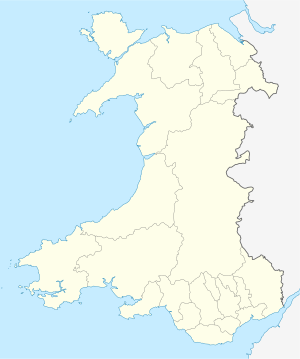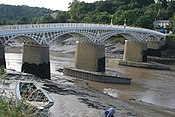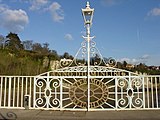Old Wyebrücke (Chepstow)
Coordinates: 51 ° 38 ′ 47 " N , 2 ° 40 ′ 19" W.
| Old Wye Bridge | ||
|---|---|---|
| Crossing of | River Wye | |
| place |
Chepstow , Monmouthshire Tutshill , Gloucestershire |
|
| construction | cast iron arch bridge | |
| overall length | 106 m | |
| Number of openings | 5 | |
| Longest span | 34.16 m | |
| opening | 1816 | |
| planner | John Urpeth Rastrick | |
| location | ||
|
|
||
The Old Wyebrücke or city bridge ( English Old Wye Bridge or Town Bridge ) in Chepstow crosses near Chepstow Castle the River Wye between Monmouthshire in Wales and Gloucestershire in England . Even in the days of the Normans there were older wooden bridges at this point . The current road bridge was built in 1816 during the Regency by John Urpeth Rastrick of Bridgnorth , who heavily modified earlier plans by John Rennie .
The bridge crosses a river with one of the highest tidal fluctuations in the world. It carried the A48 main road between Newport and Gloucester until 1988 when a new road bridge was opened a little downstream next to the railway bridge. The old bridge is now used for local road traffic between Chepstow and Tutshill. It is a Grade I building under monument protection.
Older bridges
Before the Romans came to Wales, the last bridge over the Wye before its mouth was in Tintern . The Romans built a bridge about a kilometer upstream from what is now the river crossing, and it is believed that it was in use for centuries. On the banks of Gloucestershire there was a small hospital and a chapel dedicated to St. David , which in 1573 was described as a ruin. Some of the remains of the Roman Bridge were discovered in 1911 by Orville Ward Owen during his excavations in the river bed.
After the Normans built a castle in Chepstow (the place was then called Striguil ), they built a wooden bridge over the river on the site of the current bridge or near it. The first records of a bridge in Chepstow date from 1228. It is known that this wooden bridge has been renewed several times. The new construction was made difficult by the great tidal range, which required ten 12 meter high wooden pillars, at the time probably the highest in the country. Files from 1399 describe the bridge as "weak and dilapidated and on the verge of collapse," and a bridge rebuilt in 1546 was described as "dilapidated and likely to collapse" less than 30 years later. In 1576 a law was passed (the first to explicitly mention Monmouthshire ) making Gloucestershire and Monmouthshire responsible for repairing their respective halves of the bridge. Until the 19th century there were deeds of payments from parishes in Gloucestershire for the maintenance of the bridge.
The neglect continued, however, and in 1605 it was said that the bridge had again "broken, fallen and almost torn away from the river." That year a new law was passed requiring the bridge to be supported by a special tax called “bridge money,” which was imposed on residents of the two counties. During the next two centuries, each county appointed a construction inspector to be responsible for each half of the bridge. With the exception of a stone central pillar, the bridge was built entirely of wood. During the English Civil War it was deliberately destroyed by the royalists in 1644 , but rebuilt by 1647. It was seriously damaged by storms in 1703 and by floods in 1738, but it was repaired both times. William Cole wrote about the bridge in 1746 that it was “ the lightest in England, and the highest from the water ” (German: “the lightest in England and the highest over the water”). A 1768 proposal that the two counties should share the cost of building a new bridge failed because Monmouthshire - a smaller and less affluent county than Gloucestershire - found it unreasonable to bear half the cost. However, in 1785 the wooden piers on the Monmouthshire side were replaced by four stone arches, while the half-bridge in Gloucestershire was made of wood until 1815.
The bridge from 1816
In 1810 the bridge was again declared "in disrepair" and dangerous, and the engineer John Rennie, architect of the Waterloo Bridge in London , was commissioned to design a new bridge. Rennie's plans, which would have cost an estimated £ 41,890 (in today's purchasing power £ 3,179,900), were considered too expensive. But after a ship rammed the wooden bridge in 1812, destroying part of it and causing six deaths, action finally began. The foundation stone for the new bridge was laid on April 13, 1813. The contract to build the bridge was signed in 1814 with Hazeldine, Rastrick & Co. of Bridgnorth for a contract worth £ 17,850, less than half of Rennie's estimate.
The bridge was designed by John Rastrick in a style that is obviously influenced by the works of Thomas Telford . It was made from cast iron with five arches cast in Bridgnorth. The middle opening has a span of 34.16 m, the adjacent openings 21.30 m and the outer openings 10.37 m. The bridge was opened on July 24, 1816 with a magnificent ceremony.
The bridge is the largest still existing iron arch bridge for road traffic from the first half century of iron and steel construction before the technical innovation of the suspension bridges . It is described by the architectural historian John Newman as " a supremely elegant composition of five shallow segmental lattice arches carrying the gently curved roadway ... This superstructure rests on reassuringly strong tapering piers of squared ashlar ... " Composition of five flat lattice arches that support a gently curved street ... The superstructure rests on reassuringly strong pillars made of ashlar ... "). Elaborate ironwork on the bridge marks the border between the two counties of Gloucester and Monmouth. The cast iron lampposts were purchased by Sheffield City Council and installed in 1969. The bridge was listed on March 24, 1975 as a Grade I structure.
The bridge carried the main road between Gloucester and South Wales and eventually became a notorious bottleneck. It was reinforced several times: the first time in 1889, and in 1979 there were major repairs to the structure. Except for local traffic, it was replaced by the new road bridge for the A48, which opened in January 1988.
The bridge now serves local traffic on the unclassified road between Chepstow and Tutshill; it is controlled by traffic lights at both ends. In 2015 it was closed to vehicle traffic for several months in order to carry out maintenance work on the occasion of the 200th anniversary celebration in July 2016. A member of the group that organized the celebrations described the bridge as “ the finest Georgian Regency arch bridge in Britain and the world ” and suggested that to propose it as a World Heritage Site. The anniversary celebrations also included a re-performance of the original opening ceremony. There were speeches by local politicians and by Sir John Armitt , President of the Institution of Civil Engineers .
photos
Web links
Individual evidence
- ↑ a b c d e f g h Ivor Waters: Chepstow Road Bridges 1977, ISBN 0-906134-09-9 .
- ^ A b Ivor Waters: The Town of Chepstow 1972, ISBN 0-900278-12-9 .
- ^ A b c Ivor Waters: Chepstow Parish Records 1955.
- ^ Rick Turner and Andy Johnson (eds.): Chepstow Castle - its history and buildings . Logaston Press, 2006 (English).
- ↑ a b c d John Burrows: Chepstow Bridge . Chepstow Town Council, 2015.
- ^ Robert Taylor: Taylor's illustrated guide to the banks of the Wye . Taylor, 1854, p. 24.
- ↑ Old Wyebrücke (Chepstow). In: Structurae
- ^ John Newman: The Buildings of Wales: Gwent / Monmouthshire . Penguin Books, 2000, ISBN 0-14-071053-1 , pp. 184 (English).
- ^ Road Bridge over River Wye. A Grade I Listed Building in Chepstow, Monmouthshire. British Listed Buildings, accessed January 29, 2019 .
- ↑ a b Katharine Skellon: Bid for World Heritage Status for iconic bridge. In: South Wales Argus. September 27, 2015, accessed January 29, 2019 .
- ↑ Town Trail. Chepstow Town Council, October 28, 2009, archived from the original on May 30, 2010 ; accessed on January 29, 2019 (English).
- ↑ Chepstow Bridge's 200 year-old crossing celebrated. In: BBC News. July 24, 2016, accessed January 29, 2019 .







